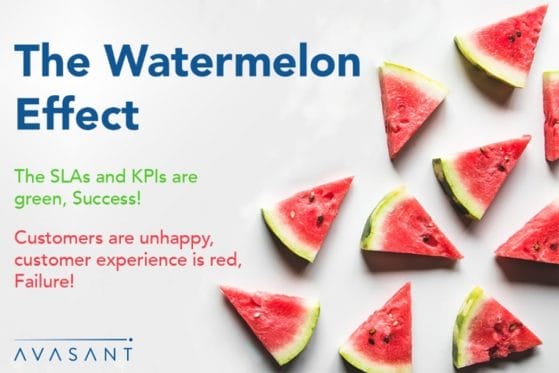Warm weather is returning, and the time to eat watermelon is back. But this is not what this article is about. What is the “Watermelon Effect” then?
Have you ever experienced, when outsourcing your services, that all your service-level agreements (SLAs) reporting and key performance indicators (KPIs) are green, but your customers or employees are not very happy with the services? This is the “Watermelon Effect.” Green on the outside, but red on the inside.

Too often those SLAs and KPIs do not reveal the real quality of service.
Service providers that only focus on contractual SLAs are highly unlikely to sustain their relationship with their clients. It is frustrating for someone sitting in the buyer’s seat to hear that everything is working fine, and the SLAs are being met, but at the same time, customers are not happy.
For example, service providers often use availability as a key metric for measuring the quality of services. A service provider might report 99.99% uptime of a system, however the 0.01% downtime happened at the most-critical time for the customer’s business. For a finance application, the most-critical time would be at the end of the month when the books need to be closed, or during a payroll run, for example. An outage during these times would cause significant damage to the reputation among users, yet the service provider downplays the effect of that particular downtime.
The service provider is focused more on availability metrics rather than customer experience. There is no point in hitting high-percentage targets if downtime still causes problems for the customer.
What can be done to prevent the Watermelon Effect?
-
- First, expectations and targets should be clearly discussed with the service provider. There should be a detailed discussion around SLAs and an understanding that SLAs should not be the only measure of service quality.
- Second, identify which SLA targets might have become obsolete. This situation arises most often in longer-term contracts. SLAs can become obsolete due to technological advancements or process improvements. Contracts should include a provision to improve targets during the contract period.
- Finally, but most importantly, customers should consider moving out of traditional SLAs and moving into XLAs (experience level agreements), where the focus is around customer experience.
XLA targets are user-centric metrics that focus on the perceived quality of IT services. These are measured by quantifying the end user experience and IT services outcomes. The major difference between an XLA and an SLA is that an XLA measures the performance in value and outcome terms, whereas an SLA usually focuses on operations and outputs.
However, there are two main challenges when it comes to XLAs.
-
- First, XLAs focus on customer experience, and customer experience can be subjective. One customer, for example, could have a bad interaction with rude support staff. This may be enough to create a long-term, negative perception of the service provider. This customer might also share this experience with others who will end up having a negative perception as well.
- Second, it is difficult to get honest feedback unless it is from a negative experience. Some people do not like giving feedback, which skews the data toward detractors and tends to show that more people have bad service experiences. Talking to all users is important in order to get a full picture.
To avoid these challenges, the process of receiving feedback should be promoted by leadership. Second, the touchpoints of customer interactions should be disclosed. This will help in clarifying the customer journey and will define exactly what is important from the customer’s perspective.
Making sure feedback is specific and comprehensive is also important. More details can often clarify the difference between a subjective response of a few negative users and a truly unsatisfactory experience.
The Watermelon Effect can be reduced. If service providers want customers to be happy, push them to give feedback so that the right expectations are set up front.
By Ashish Verma, Senior Consultant, Avasant

